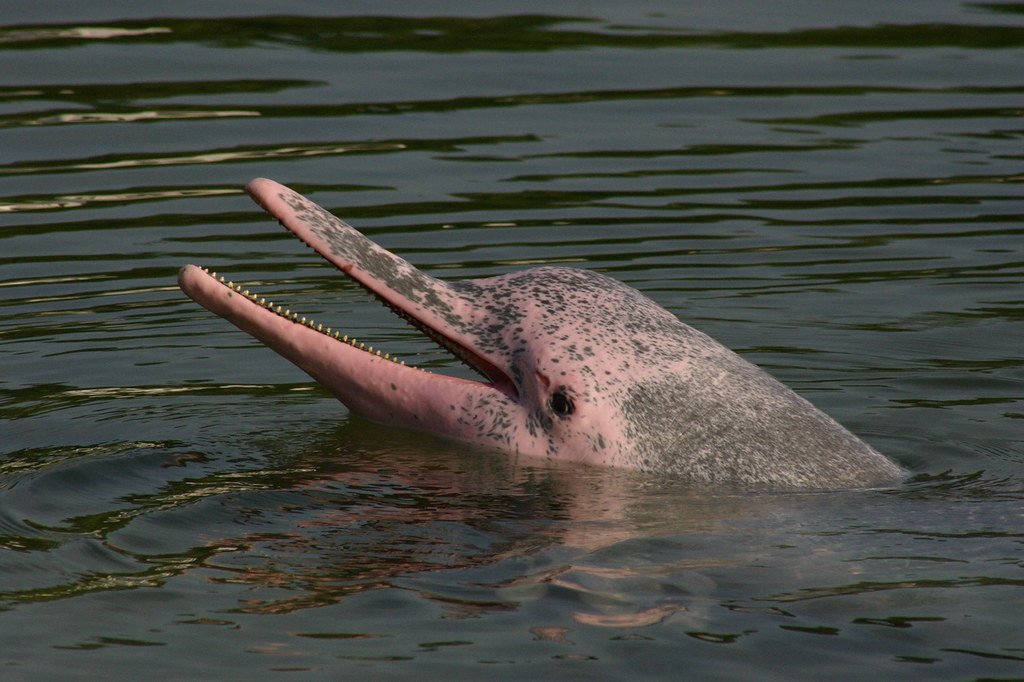Picture this: you’re casting your fishing line into the murky waters off Louisiana’s coast, expecting maybe a red snapper or speckled trout. Instead, something that looks like it swam straight out of a fairy tale breaks the surface. That’s exactly what happened to Thurman Gustin last summer, and his video has marine biologists buzzing.
The rare pink dolphin isn’t just a social media sensation. It’s a living testament to the ocean’s most extraordinary genetic surprises. According to some reports, very few dolphins with albinism have been spotted in the Gulf of Mexico in recent decades, and this particular pink dolphin, nicknamed “Pinky,” was first photographed back in 2007.
The Science Behind the Pink Wonder

Albinism is caused by mutations in genes that affect melanin production, and when melanin is absent from a dolphin’s skin, blood vessels become visible through their colorless skin, creating that distinctive pink appearance. It’s like nature’s own rose-colored glasses, except the dolphin is wearing them permanently.
True albinism is identified by a complete or near-complete lack of pigment, resulting in white skin and pink or very light-colored eyes, though genetic testing is the only definitive way to confirm albinism. Scientists estimate that albinism in mammals occurs in approximately one of every 17,000 to 20,000 births, making these pink dolphins rarer than lottery winners.
Meet Pinky: Louisiana’s Pink Celebrity

This extraordinary dolphin was first spotted and photographed by Captain Erik Rue of Calcasieu Charter Service on June 24th, 2007 during a charter fishing trip on Calcasieu Lake south of Lake Charles, Louisiana. When first spotted in 2007, she appeared to be a newborn youngster traveling with mama.
Pinky is confirmed to be female after being captured on film actively mating with a male dolphin, and she has birthed at least two calves in her lifetime. Talk about breaking stereotypes – this pink maverick has proven that different doesn’t mean disadvantaged. Charter captain Erik Rue describes Pinky as a curious dolphin who occasionally swims within five to 10 feet of his boat.
The 2023 Viral Sighting

Houston native Thurman Gustin and his girlfriend were out fishing in a Louisiana channel when they spotted two bright pink dolphins, leaving them “freaking out”. Gustin stopped the boat, pulled out his phone and immediately started filming, though he was only able to capture the larger of the two dolphins on video, saying “I have never seen anything like it and just wanted to save the memories”.
This was Gustin’s first time seeing a pink dolphin in his 20 years of fishing, and he acknowledged getting “very lucky, because such a spotting is extremely rare”. The second dolphin in his video sparked speculation about Pinky’s offspring – a possibility that had marine biologists holding their breath.
The Mystery of Pink Dolphin Genetics

When Pinky was seen mating with several male dolphins in 2016, it was unclear whether her progeny would also be pink, because her mate would need to carry the gene for albinism to make that possible, with only a 50 percent chance of producing a pink calf. It’s like rolling genetic dice where the stakes are a living rainbow.
Albinism generally occurs because of gene mutations, causing the cells that produce melanin in hair, skin, and eyes to produce very little pigment or none at all. The trait is typically recessive, so Pinky likely received one recessive allele from each of her parents. Nature’s lottery system at its finest.
Survival Challenges in the Wild

Albinos in the wild can be shunned by others in their group or make easy targets for predators, and most albino alligators are taken by predators before they reach adulthood, while albinos are also more susceptible to diseases. Yet Pinky has defied these odds for over 15 years.
Albino dolphins may have shorter lifespans due to increased susceptibility to sunburn, skin cancer, vision problems, and predation. The trait can occur across the animal kingdom, though albino animals often face obstacles to surviving in the wild, including poor eyesight. Still, Pinky keeps proving that sometimes being different is actually being stronger.
The Calcasieu Ship Channel: Pink Dolphin Territory

The pink dolphins were spotted in Louisiana’s Cameron Parish, which borders the Gulf of Mexico, and Pinky is described as “a well-known resident of that area and is often seen in those waters” by the Audubon Coastal Wildlife Network. This specific stretch of water has become something of a pink dolphin highway.
In 2017, a woman claimed to have seen two pink dolphins playing together in the Calcasieu Ship Channel, though she wasn’t able to capture them on video, and then in 2018, two bright pink dolphins were filmed swimming alongside a ship in the channel. The locals even got creative with naming – the second dolphin was dubbed “Brain” in honor of the cartoon “Pinky and the Brain.”
Scientific Significance and Research Value

Albino bottlenose dolphins are exceptionally rare, with very few confirmed sightings worldwide. Albino dolphins are exceptionally rare, and while precise global figures are impossible to obtain, confirmed sightings are few and far between, indicating that albino dolphins are among the rarest color variations found within dolphin populations.
Due to their rarity, dedicated research on albino dolphins is limited, though genetic studies and observational data from sightings contribute to our understanding of albinism in marine mammals. Each Pinky sighting is like finding a piece of nature’s rarest puzzle – scientists treasure every photograph and video.
Conservation and Protection Efforts

Given the rarity of albino dolphins and the challenges they face, conservation efforts are crucial, and protecting their habitats from pollution and overfishing, as well as minimizing human disturbance, can help improve their chances of survival. Pinky has become more than just a curiosity – she’s a symbol of what we stand to lose.
All dolphins are generally protected under marine mammal protection acts in many countries, and these laws prohibit harassment, hunting, and other activities that could harm them. The work of organizations dedicated to marine mammal research and conservation is vital in understanding and protecting these unique creatures. Every sighting report helps scientists track Pinky’s movements and health.
Conclusion

The rarity of albino dolphins makes them truly exceptional creatures, and their struggles highlight the importance of conservation efforts and the need to protect all marine life, with every sighting providing valuable insights and emphasizing the critical role humans play in ensuring their survival. Pinky has survived against astronomical odds, thrived in challenging conditions, and even reproduced successfully.
This pink ambassador of the deep reminds us that nature’s most beautiful surprises often come in the most unexpected packages. What do you think about these remarkable pink dolphins? Tell us in the comments.




